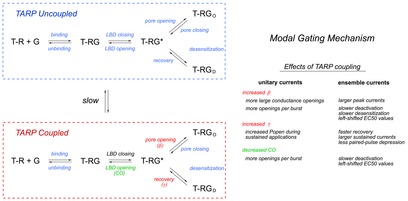Figure 5. Modal gating mechanism.

A tiered reaction scheme (left) where, in the presence of TARPs, individual receptors switch on a time scale of seconds between two distinct sets of receptor conformations represented by the simplified kinetic mechanisms boxed in blue and red. The rate constants controlling transitions between discrete states in the top mechanism are indistinguishable from the corresponding rate constants in the absence of TARPs (TARP uncoupled). The TARP-coupled mechanism differs primarily in the rate constants for pore opening and recovery from desensitization. Increases in these rate constants, and perhaps greater stability of the closed LBD/closed pore transition state (T-RG*), result in the changes in unitary and ensemble currents summarized on the right side of the figure. TARP coupling results in larger and more slowly decaying synaptic currents and reduces the blunting of synaptic responses due to desensitization during trains of repetitive stimuli.
